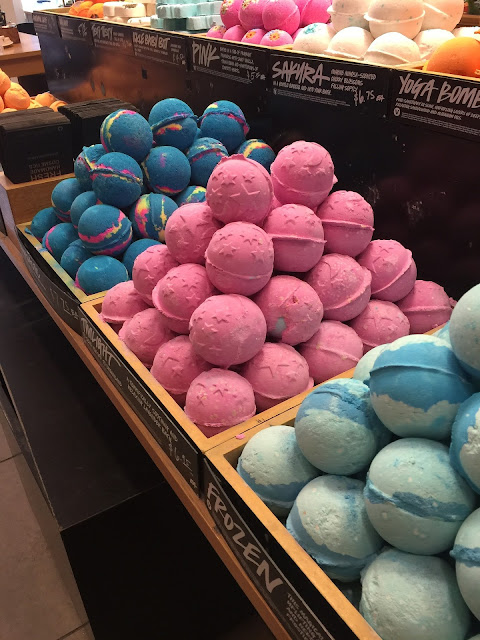Demystifying Bath Bombs - What You Didn't Know
Tuesday, April 18, 2017There was a time when women just use pure milk and honey as their bath soak which was popularized by Cleopatra. Nowadays, cosmetic companies have revolutionized the way we take our bath with the invention of bath bombs. Bath bombs come in various sizes, shapes, colors and scents. These “bombs” became fizzy when they come in contact with water. Unfortunately, behind those beautiful colors, what people don’t know is that most commercial bath bombs contain additive ingredients that can be harmful to our body with prolonged usage.
Sydney Ziverts, Health & Nutrition Investigator from ConsumerSafety.org, has shared to me her own findings about bath bomb ingredients that we need to be cautious of. Here is the list of those ingredients.
Synthetic Fragrances
If you see bath bombs with “fragrance”, “fragrance oil” or “fragrance oil blend” as one of its ingredients instead of the natural “essential oil”, then beware of using them. Fragrance oils are derived from petroleum and other toxic components like:
Benzene Derivatives
Benzene is a clear, colorless liquid with a sweet aromatic odor. It is used mainly as a starting material in manufacturing other chemicals including detergents, pesticides, dyes and perfumes. Even TOXNET (Toxicology Data Network) includes benzene in their database of toxic chemicals.
Potential Dangers: Human carcinogen, hormone disruption, reproductive malformation, lower immune response (which can increase the chance of infection)
Aldehyde
Aldehyde is a common perfume additive that is used to enhance the fragrance of cosmetic products.
Potential Dangers: Respiratory allergies, liver disease, embryo toxicity, diabetes/hypertension, sclerosing peritonitis, cerebral ischemia/neurodegenerative diseases and other aging-associated diseases
Phthalates
Phthalates are often used in cosmetics and personal care products to make their fragrance lasts longer. According to this article by Tox Town, it will take high exposure to phthalates before you can experience its adverse effects on human reproduction or development.
Potential Dangers: Human carcinogen, decreased hormone levels, low sperm quality, ovarian aging
Glitters
Most bath bombs contain glitters or microplastics that add shimmer to the product to make it look more appealing. These tiny plastics are non-biodegradable so once they get washed down the drain, they end up in our waterways where marine creatures might ingest them and when we eat fish we somehow indirectly ingest them too. In other words, glitters are not environment-friendly.
It is also important to note that glitters can upset the healthy vaginal pH (between 3.8 – 4.5) which can make you more susceptible to UTI and yeast infection.
Artificial Dyes
Bath bombs are famous for their beautiful rainbow colors. However, this study found that certain dyes can actually be absorbed into our blood system most specifically through recently shaven skin. High exposure to artificial dyes can also possibly cause behavioral problems in children (e.g. ADHD) and can be carcinogenic as well.
Talc
Although this ingredient is not extremely popular in bath bombs, it’s been found in a few products of a well-known brand. Talc is sometimes used as filler for bath bombs. Also, there have been some studies linking talc to ovarian cancer.
Parabens
Parabens are what I considered as the most controversial preservative which are subject to several debates. Some studies say that parabens are potential endocrine (hormone) disruptor because of their ability to mimic estrogen and estrogen is one of the hormones responsible for developing breast cancer. Again, the topic of linking parabens to breast cancer is still debatable. If you want to be sure of your health, then it’s better to minimize or completely eliminate the use of products with parabens.
Now, I want to emphasize that the above list of bath bomb ingredients may have “potential” dangers. “Potential” because people react differently to these chemical ingredients that’s why there are some who are more prone to acquire diseases when expose to certain harmful chemicals for a long period of time.
Are there any safer alternatives to commercial bath bombs? Yes, there are. Here are some simple solutions to make your bath time enjoyable and safer (Thanks Sydney for these tips!).
DIY Bath Bombs
Actually, the main components of bath bombs which are sodium bicarbonate (baking soda) and citric acid (responsible for the fizzing action) are perfectly safe. It’s the additives such as artificial fragrances and dyes that made them harmful. Why not just create your own bath bombs without those additives. Here is an example of DIY bath bombs from WellnessMama that only uses essential oil and does not contain any food colorings.
Scented Candles
If you want to have a calming aroma while soaking in your bath tub, then you can just use scented candles (preferably the non-toxic soy wax or beeswax candles). The soft light from the candles will also set the mood for relaxing.
Homemade Bubble Bath
Instead of obsessing over the fizzing effect of bath bombs, you can just create an all-natural bubble bath. This is better since the bubbles will remain until the end of your bath unlike the fizzing effect of bath bombs which will only last for a few seconds.
LED Bathtub Lights
If you really want to have some pop of colors without dipping yourself in toxic dyes, then you can try submersible LED lights to illuminate your bathtub from below.
Do you have other safer alternatives to commercial bath bombs? Let me know on the comment section below :)










0 comments